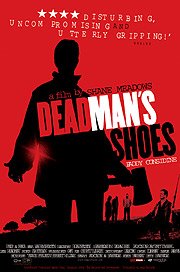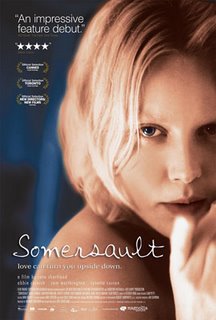Dead Man's Shoes
 If revenge truly is a dish best served cold, the lead character of Dead Man’s Shoes is perfectly suited to the task. The movie focuses on one man’s quest to pay back a group of low-level hoodlums for their mistreatment of his mentally handicapped brother. Paddy Considine plays the protective brother and also co-wrote the script, and while he’s far from a household name in the US he puts in a bravura performance here that goes a long way towards removing him from the “that guy in that movie” column of co-starring roles to well-deserved lead status.
If revenge truly is a dish best served cold, the lead character of Dead Man’s Shoes is perfectly suited to the task. The movie focuses on one man’s quest to pay back a group of low-level hoodlums for their mistreatment of his mentally handicapped brother. Paddy Considine plays the protective brother and also co-wrote the script, and while he’s far from a household name in the US he puts in a bravura performance here that goes a long way towards removing him from the “that guy in that movie” column of co-starring roles to well-deserved lead status.Considine’s character Richard has been away from home serving his country in the military, and in his absence his highly impressionable little brother has been adopted as a mascot by a local gang of drug dealers. They take him under their wings, allow him to hang out with them, but generally mistreat and degrade him as frequently as possible. He’s powerless to escape the situation as he seems to crave their attention and companionship in the absence of his protective brother, and his mental deficiencies prevent him from grasping the true nature of their dysfunctional relationship. His interactions with the gang are shown as flashbacks throughout the film, but the main story arc begins with Richard’s return home after leaving the military.
Upon his return, Richard begins making a nuisance of himself to the local hoods, shadowing and occasionally confronting them for no apparent reason. We’re gradually clued in that he’s not happy about how they treated his brother, but the severity of the situation isn’t made clear until well after Richard begins systematically executing every member of the gang. The murders are fairly gruesome, but they’re not played for horror and Richard never seems like a terrifying boogeyman, just a man on a mission. In other words, don’t let the spooky silhouette of the axe murderer on the movie poster lead you to believe this is a horror film.
The film is not without its faults in both structure and technical details. From a technical standpoint, the sound is far from stellar due to muddled speech recording coupled with frequently invasive soundtrack volume levels contributing to make the extremely thick British accents even more incomprehensible for us Yanks. Subtitles would be welcome to fully grasp everything going on, but luckily much of the dialogue seems to be ad lib and non-essential to following the story.
As for structure, the use of incomplete and chaotic flashbacks to convey the back story leaves enough gaps in the central plot that viewers are left questioning Richard’s motivation for murder until the final 15 minutes of the film. The flashback device is simply not effective, especially due to the amateurish use of handheld super 8 black and white footage to set the scenes apart from the present day.
About those final 15 minutes though: they more than make up for the mess leading up to them as everything snaps into focus. Richard’s heartbreak and regret are overpowering in the waning minutes, and the strength of Considine’s performance makes them absolutely essential viewing, redeeming the entire production.



